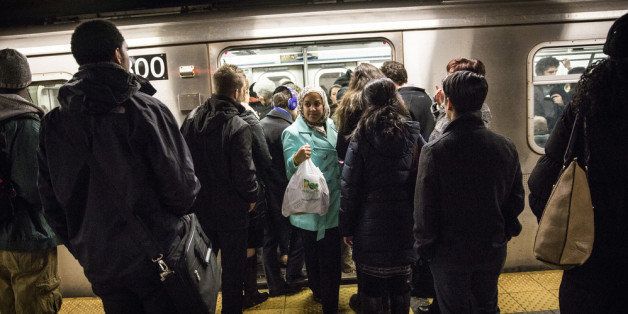
For a rush hour train headed to Canal Street, the N was remarkably empty; 12 of us all had seats between two sets of doors when the Latino guy across the way started making crazy noises. Then he started flailing his arms about -- real crazy, and we were looking at each other, trying to assess just how dangerous this might be. And then every part of the man's body was moving, and we knew: he wasn't nuts; he was having a seizure.
It took a moment to react to this, a moment when he jerked out of his seat and collapsed onto the N train floor. Those nearest him were moving now. A woman started demanding that we give him space. As I hauled my market cart out of the way of the man's spasmodic jerkings, I noticed she wore blue hospital pants. Nurse? Medical technician? It didn't matter. She was the most knowledgeable; she was in charge.
Someone else hit the alarm button. Another man removed the victim's glasses so he wouldn't cut himself. A third found the guy's cell phone, couldn't figure out how to use it. The nurse grabbed it, started searching out the recent callers. Maybe she'd have a moment when we were above ground. The squawk box sputtered, and I gave the conductor the number of the car.
Meanwhile, the seizure victim had stopped moving. A young man in a quilted jacket, casual black pants, black shoes -- the closest thing to the stereotype Brooklyn hipster in our group -- dropping to his knees to check if the guy was still breathing. He was, but the young man's hand remained on the victim's back for comfort. It would stay there for the rest of the incident.
The conductor came -- like all the subway workers we saw, African-American -- pulling on gloves, following protocol, and explaining that since we had passed DeKalb, there was nothing that could be done until we reached Canal Street. And that he had to go back to his position so that the doors would open once we arrived.
A young woman, white, who looked like an office worker, took out a few tissues so that there would be something between the victim's face and the floor. The not-quite hipster kept his hand on the young Latino man's back. The nurse kept watch. The rest of us looked at each other.
Because the N train runs the entire length of Brooklyn, we were war-movie diverse: whites, blacks, Latino, Asian; in working, casual and business attire. Right now, a sudden community. A community that had popped-up the moment the seizure had started. We barely spoke to each other, but we all had a single focus. We watched a member of our unexpected group breathe on the train's floor. We wanted one thing: for him to keep breathing.
The nurse couldn't find a number to call while we were on the bridge, and the train took forever to reach Canal Street. The man began to stir. He was confused, disoriented. It was unclear if he didn't understand English or simply didn't understand anything in his condition.
When the N finally arrived at Canal Street, we were the first to peer onto the platform. No EMTs in sight, but plenty of concerned transit workers.
The conductor announced that the train would not be moving because of a medical emergency and that passengers should exit and take the R train. Everyone on that N train left except for our small group. We were not going to abandon the man on the floor, not until he was safe and in someone's care.
He started to get up and was helped him to a seat.
Finally, the EMTs arrived and the man was led off the car. The medical worker and the young man in black went with him. They had been closest and they would follow through.
The rest of us looked at each other. Strangers entered the car. The doors closed. At Union Square, some of us left the others behind.
As I moved through the Greenmarket -- a community of affinity, not need -- I realized that I would never learn who the victim was or what had become of him.
This is New York, where anonymous strangers form communities. Some are based on work, some grow in neighborhoods, some coalesce from interest. And some arise when the need arises: we bring ourselves together, and then, when the impetus for the community's formation ceases, we dissolve into the larger city from which our pop-up community sprang.